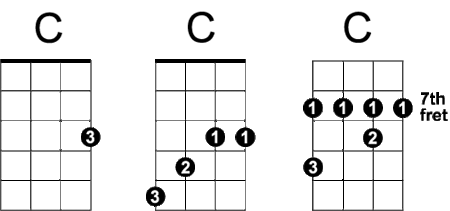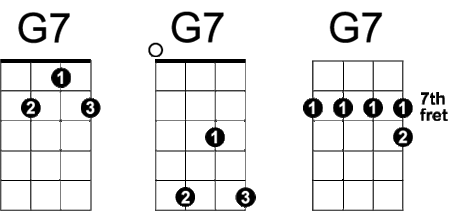The Phantom Teacher
By James Hill
Teach without saying a word. Yes, it's possible. In fact, it's an essential part of your teaching skill set. Learn how in this to-the-point article on differentiated instruction strategies.
The Phantom Teacher(Printer-friendly PDF format):
This article is in C6 tuning (g, c, e, a).
Click here to read in D6 tuning (a, d, f#, b).
"Differentiated instruction" is education jargon that, put simply, means "tailoring teaching to the needs of each student." It's a good idea. But how can one teacher simultaneously accommodate many different learning styles and levels of ability? How can a teacher at once challenge advanced students and accommodate the needs of beginners?
In my view, there are three main ways to differentiate your approach to ukulele instruction:
Arranging: Choosing (or creating) arrangements that are built with differentiation in mind. For example, a two-part arrangement in which Uke I is more challenging than Uke II. Examples of this abound in the Ukulele in the Classroom series, as well as in many Ukulele Yes!arrangements.
Mentoring: Giving advanced students the responsibility of mentoring less-experienced and/or less-able students. Depending on the age of your students, this may include student-led break-out groups, student demonstrations and/or extra-curricular mentoring.
Modeling: The focus of this article, modeling means subtly demonstrating more advanced skills that may interest students looking for a challenge without distracting students who aren't yet ready for more.
When the Student is Ready...
There's an old saying, "when the student is ready, the teacher will appear." A variation on this might be, "the student will not see a skill until he is ready to see it." When a teacher uses effective modeling, enrichment-level skills are "visible" only to students who are ready to see those skills. It's the teaching equivalent of being in two places at once; at best, it's like having a teaching assistant (who works for free!). Hence the term "phantom teacher."
In this article I'll elaborate on two time-tested strategies for putting your own phantom teacher to work: 1) barre chords and 2) arpeggios.
Do not stop the class to demonstrate exactly what you're doing; let the student figure it out if he/she so desires.
1. Barre Chords
Try this strategy once your students are familiar with the most common way to play chords like C, F, and G7. Without calling attention to what you're doing, simply start playing a barre chord voicing of one or more of these chords whenever you can. The student who is ready for a challenge will ask: "What is that chord you're playing?" or "Why aren't you playing the same chord as me?" At that point you might briefly say something to the effect of:"There are many ways to play a C chord; I'm playing a more advanced version." Do not stop the class to demonstrate exactly what you're doing; let the student figure it out if he/she so desires.
Here are some common inversions of C, F and G7 to have at your fingertips.
2. Arpeggios
Here's another strategy to implement once students are familiar with simple chords. Instead of strumming with the thumb or index finger, play an arpeggio. To "arpeggiate" a chord, simply play the chord one note at a time. This is usually most effective on slower, more lyrical pieces (e.g. Down in the Valley or The Cruel War).
Here are a few arpeggio patterns to learn and use when one or more of your students needs a challenge. As with barre chords, there is no need to explain in detail at first. Let your more advanced students figure it out and, ideally, teach one another. Note that each of the examples shown below is a pattern that can be used on any chord, not just the one shown in the example.
Click score to enlarge.
Conclusion
Notice that the strategies detailed here depend on one thing: your own ability to play the ukulele at a higher level than your students. This is very important. I've said it before and I'll say it again: the fastest, easiest and most enjoyable way to improve your teaching is to improve your own playing. Fall deeper in love with the ukulele; both you and your students will reap the rewards!
The "phantom teaching" (i.e. modeling) techniques detailed here are just the tip of the iceberg. If you have further suggestions for differentiated instruction, please leave a comment at the end of this page. The community of ukulele teachers will be better for it!
James Hill is editor of Ukulele Yes!, co-author of Ukulele in the Classroomand director of the annual Langley Ukulele Workshop. He also maintains a busy touring schedule as a performer; his latest CD is Man With a Love Song. Visit www.jameshillmusic.com for more.








This month, Cynthia Kinnunen gives us some intervalactic tactics
Building recognition of intervals aurally (by ear) and on the page (by sight) helps to improve many aspects of our musical learning, including sight reading, sight singing, harmonizing and more! But knowing where to begin teaching intervals can leave us feeling like we’re on another planet.